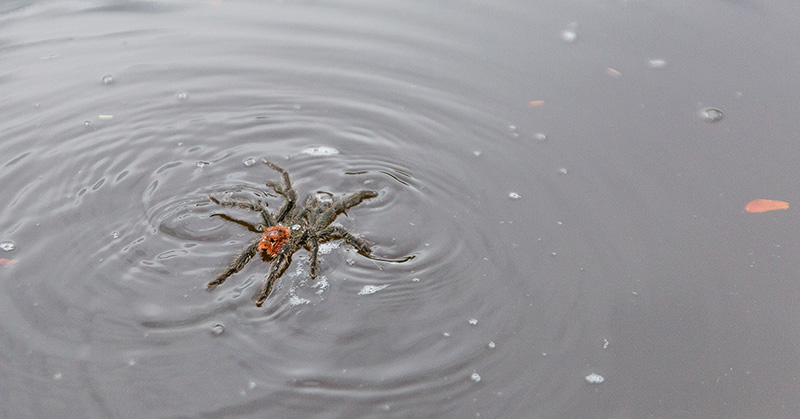Rowing gently down the stream like he owns the whole darned place…
This trending video of a giant hairy tarantula crawling across the water is certain to leave a lot of viewers hydrophobic. It’s not that most bodies of water aren’t usually crawling with aquatic insects, but there’s just something really sinister about this one, and spiders aren’t usually thought of as aquatic.
The diving bell spider (Argyroneta aquatica) is one of few spider species that spends most of its life “underwater”. When they are on land, their color usually changes to a lighter shade of brown. This incredible spider (sorry, arachnophobes) channels air from the surface into the web around its body, forming a sort air bubble it could use as an oxygen tank.
But who knew TARANTULAS could swim, too? Certainly not me.
Right before Halloween in 2018, the footage was recorded by researchers at the Big Bend Ranch State Park-Texas Parks and Wildlife, in Texas, U.S.A [1]. The arachnid might have been an amateur, but it was swimming pretty nicely, never sinking in the reasonably turbulent water.
The researchers at the park studied the swimming mechanism of the giant tarantula. It was observed that due to the plasticity of their exoskeleton, the spiders could quickly alternate the movement of their 8 legs, use them as oars to paddle in any direction. Tarantulas don’t usually like to swim so much, but when the need arises, they put their eight legs to good use.
According to arachnologists, these spiders are more cowardly than they look. If you don’t bother them, they’ll most likely not bother you and will actually try to hide from you. In any case, if you see a spider rowing across the water, it’ll be best for everyone if you call the attention of the lifeguard.
Should you be worried about swimming spiders?
Spiders may bite if a person gets too close, which could be quite painful and scarring. However, their bites are only as venomous as a worker bee’s, which means they are relatively harmless to humans [2]. Only very rarely would a tarantula bite cause serious harm. Most spiders (excluding black widows, brown recluses and that small clique of poisonous spiders) do not produce deadly bites.
Marine experts are reassuring you that you won’t really be seeing a lot of spiders rowing across the water this summer. According to Jason Dunlop of the University of Manchester, “Most tarantulas probably never have to face the need to swim, but it is clear that if they must swim, they have the behavioral plasticity to do so,” he said in a publication of the American Tarantula Society [3].
Swimming spiders are a rare sight and only happens in certain locations and definitely not in all waters. Have fun this summer and enjoy the water without fear.
But don’t forget to have your camera handy in case you find yourself a hairy, 8-legged swimming partner…
- O’Sullivan, Kelly. Um, Did You Know That Tarantulas Can Swim? Country Living. https://www.countryliving.com/life/a28073510/swimming-tarantula-video/. Retrieved 02-07-19
- Goldenberg, Alina. Are tarantulas dangerous? Boys’ Life. https://boyslife.org/outdoors/wilderness-first-aid-qa/37890/are-tarantulas-dangerous/. Retrieved 02-07-19
- Dunlop, Jason. Swimming in Tarantula. American Tarantula Society. https://www.atshq.org/articles/swimming.pdf. Retrieved 02-07-19
- Admin. Diving Bell Spider: Anatomy, Habitat, Bite And Other Facts. Science ABC. https://www.scienceabc.com/nature/animals/diving-bell-spider-anatomy-habitat-bite-facts.html. Retrieved 02-07-19
- Big Bend Ranch State Park-Texas Parks and Wildlife. Facebook Page. https://web.facebook.com/BigBendRanchSP/. Retrieved 02-07-19
- MacWelch, Tim. The 10 Most Dangerous Spiders in the World. Outdoor Life. https://www.outdoorlife.com/photos/gallery/survival/2011/10/10-most-dangerous-spiders-world/. Retrieved 02-07-19

